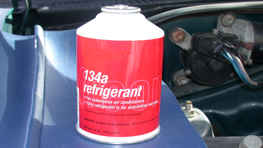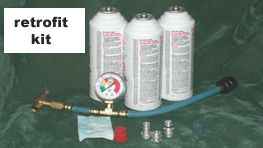Although you may not realize it, the refrigerant in your car's air conditioning system cools the air by removing heat from the passenger compartment. As a fringe benefit, the refrigeration process also dries the interior air. Hence, the term air conditioning.
R-12, commonly referred to as Freon® was the first refrigerant used in automotive air conditioning systems and continued to be used in new cars through the early 1990 model years. This ended the era of R-12 as a "factory fill," because scientific research begun in the 1970s consistently showed that the chlorine contained in R-12 contributed to depletion of the earth's stratospheric ozone layer. Thinning of the ozone layer increases the harmful effects of excessive ultraviolet radiation, resulting in increased incidents of skin cancer, crop damage and even an increase of ground-level ozone, which triggers photochemical smog. Because of this, the U.S. Environmental Protection Agency (USEPA) called for an end to R-12 production at the end of 1995.
This drove refrigerant and motor vehicle manufacturers towards finding an alternative refrigerant to R-12. Because of its safety, performance and non-ozone-depleting characteristics, a new refrigerant called R-134a was chosen as the successor to R-12. Automakers started their switch from R-12 to the new ozone-friendly refrigerant, beginning with 1992 models. The changeover was complete with all 1994 makes and models and R-134a continues to be used as the original equipment refrigerant in all makes and models today.

Other Alternatives: Although the quest to replace R-12 resulted in alternatives other than R-134a, you should be aware that R-134a is the only refrigerant recommended by carmakers when retrofitting. In some rare instances on older cars, R-134a may not perform properly so another alternative refrigerant may need to be considered. Also, care must be used when considering other alternatives, because they have to be accepted by the EPA for safety and include specific use conditions. The EPA classifies some alternative refrigerants as unacceptable, for reasons such as flammability. On that note, it is illegal to charge an A/C system with an unacceptable refrigerant.
Mixing Refrigerants: Refrigerants should never be mixed. That is, adding a different refrigerant to what's already inside the system. If mixed together—something called cross-contamination—the unknown refrigerant blend may yield poor A/C system performance and could even damage the system. Service equipment connected to an “infected” system could then become pull in some of the unknown blend, which could then unknowingly be passed on to other vehicles during service. For these reasons, refrigerant has to have its own unique of service fittings as a means to help deter refrigerant mixing.
Refrigerant Oil: A/C systems carry oil through the system with the refrigerant to lubricate various parts such as the compressor. R-12 systems traditionally used mineral oil for this purpose, but this does not work well with R-134a. As a result, two new types of refrigerant oils emerged that are compatible with R-134a: PAG oil and POE (ester) oil. Many car manufacturers now use PAG oil in systems originally equipped with R-134a. Aftermarket companies, on the other hand, often choose ester oils for lubrication with R-134a because they tend to attract less moisture than PAG oils. This makes ester oils better suited for in-service situations. For best results, follow the exact instructions of the company supplying the retrofit kit for correct oil type and quantity.
Repair or Retrofit? The end of R-12 production triggered a market for alternative refrigerants other than R-134a and for a procedure known as retrofitting—converting a system to use a refrigerant other than the one originally used. Usually, this option arises after a system repair, such as fixing a leak or parts replacement. Since any refrigerant still left in the system must be removed with the proper equipment by a technician with certification credentials approved by the EPA (it is illegal to vent any refrigerant), this presents a good time to think about switching. Here are some things to consider.

One option is to simply repair and recharge the system, if the system repair is simple enough. From there, you could simply have the system recharged with R-12 and your A/C system would be back in operation. Problem is, as R-12 supplies continue to dwindle and prices continue to rise, repairing and recharging with R-12 will become increasingly cost-prohibitive and R-12 may soon be next to impossible to find. To compound this further, EPA estimates that R-12 A/C systems lose 12 percent of their system charge on average each year. Finally, R-12 has a sales restriction, which means that it can only be sold to technicians with certification credentials.
In most cases, your most economical option if your car is equipped with R-12 is to repair the system and retrofit it to R-134a. Once again, any refrigerant still left in the system must be removed with the proper equipment by a technician with certification credentials approved by the EPA (it is illegal to release refrigerant into the air). The exact steps required for retrofitting vary depending on the year, make and model of car, but most often the process involves changing certain system components, changing service fittings, adding R-134a-compatible refrigerant oil and charging the system with R-134a, then finally applying a new system label that states the new type of refrigerant is R-134a.
There are no laws or mandates that require you to retrofit your car's A/C system and there is no sales restriction on R-134a; it's a decision best made by you based on economics and circumstances related to your car (model year, condition, keep or trade, etc.) It is your best interest to allow a professional technician to perform all services related to refrigerants.

